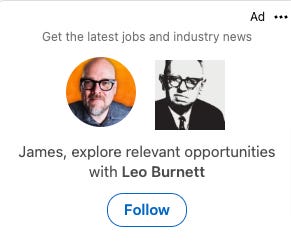LinkedIn Ads finally figured out how to target people
OR
Separated at birth?
OR
How to properly tailor your resume to the job
As we talked about last week, EVPs are supposed to be the way we define what makes us a great choice of employer over other options.
So what do EVPs look like lately?
Let’s take a recent article from Built In listing “24 EVPs to Inspire.” These are supposed to be great examples of employer value propositions. What do we get?
One: Talking to customers instead of candidates. For example: “We strive to be the very best at what we do” and, “We have a smart, ambitious team dedicated to delighting our customers” and “We’re an industry pioneer that’s been leading the way for over a decade” and “Join the team that’s helping drive more customers to the world’s local businesses.” These are consumer messages, not recruiting ones.
Two: Say things that are probably true at almost every company. “We love what we do and strive to do the best work we can each day” and “When smart people work on intriguing problems, and they enjoy coming to work each day, they accomplish great things together” and “We’re looking for friendly, creative problem solvers to join our team” and “Our incredibly diverse, insanely skilled team is making amazing things happen every day.” I could easily apply these messages to IBM, Ford, Tik Tok or PwC. How is this helpful information?
Three: Talk about what a company wants rather than what they offer. “We are looking for people who are passionate, curious and collaborative” and “Looking for builders and true believers who are comfortable disrupting the norm” and “Employees who are creative, energetic, proactive, and intelligent in both their thoughts and actions.” What value is being proposed, here?
Four: Magical claims. “We believe our winning culture sets us apart.” and “We have a phenomenal culture and unparalleled drive” and “Our team is high powered and committed.” You’ve cracked the code of culture where millions of companies before you failed? Amazing! And you have some magic beans to sell me? You got it!
Exactly Who Wants This Information?
While I am certainly cherry-picking, there’s nothing here to inform a candidate about what they should expect in concrete or credible terms, or why they should choose this company over the other 23 on just this list, let alone the tens of thousands of other companies looking for similar hires.
The root cause is a disconnect between the audience expected to absorb this information (applicants and candidates) and the audience approving and paying for it (leadership). Executives are not incentivized to create a clear and credible picture of the company, and so they treat EVPs as opportunities to say nice things about the companies they lead. As you can see in the above examples, they are just as concerned about using the EVPs to talk to consumers as they are candidates, diluting their value.
Presenting the rosiest and glossiest possible picture may appeal to the C-Suite, but it doesn’t inform the candidate. Upon being fed a steady diet of generic platitudes and aspirational spin, candidates with options will gravitate to a place that reveals a more complete picture of working there. And that means the good and the bad.
And because they only show the positives, these EVPs are effectively designed to attract the maximum amount of interest. Employer branding is possibly the only aspect of marketing where getting more leads is detrimental to success. Where consumer and corporate marketing want the maximum number of leads to sell to, employer branding wants fewer applicants of higher quality. While every dollar is a good dollar in sales, every applicant is not a good applicant. It is the only place where quality trumps quantity.
Thus, EVPs aren’t serving companies because they aren’t serving the candidates.
So is there a better approach to EVP development, one that provides the outcomes that businesses and hiring managers are demanding? There is. And we’ll walk through what that model looks like next week.
.
🧮 Treasure trove: more than 150 decks from agencies, consulting firms, banks and a WHOLE lot more on what the trends for 2024 look like. Your boss will be impressed AF when you’re citing research from McKinsey, TrendHunter, Tik Tok, AdWeek and Goldman Sachs »
🧠 Uncle Seth reminds us of eight marketing maxims that will help you build your reputation internally. »
🦾 What does it take to build a skills-first talent strategy? MIT Sloan webinar recording goes pretty deep. »
✳️ The best leaders don’t create followers. They create more leaders. 13 ways to build the next generation of leadership. (Spoiler: who wins when you create leaders in other places? You do.) »
🏳️🌈 Katrina Kibben has an inclusive hiring workbook that is worth your time. »
🧠🔌 AI Idea of the Week: What does the “cutting edge” of AI and content marketing look like at the moment? »
🏛️ All 2,200+ articles from this newsletter are in a searchable archive. Go get ‘em!
“Desire offers rationalizations instead of rationality”
- Scott Galloway
Just because I am that kind of nerd, I bought employerbrand.ing
NEW: Employer Brand Buyer’s Guide »
105 free (or almost free) ways to activate your brand »
Employer Brand Breakdown series »
Biotech Recruiting limited run email course »
Proof employer brand works »
Biotech Recruiting Chat series »
Employer Brand minute series »
The Brand Plan podcast »
The Talent Cast podcast »
On-demand video courses »
***This Newsletter Contains No ChatGPT***
-James Ellis [LinkedIn] [Website]
###











Great article. Love your points and will take into account.